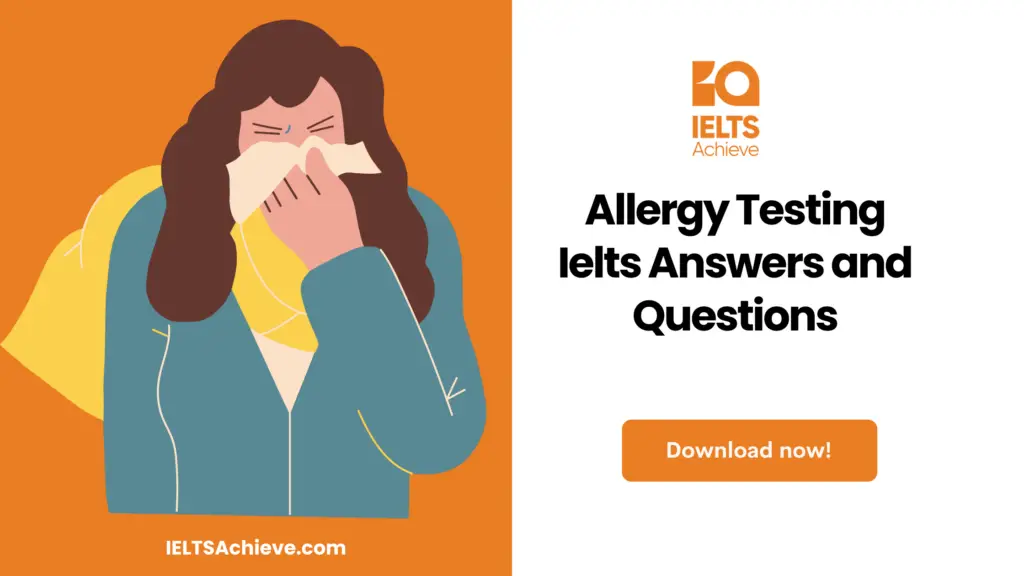The Blog post contains the following IELTS Reading Questions:
- IIELTS Reading Matching Headings Questions
- IELTS Reading Summary Completion Questions
- IELTS Reading Locating information Questions

IELTS Reading Passage – Allergy testing
Allergy Testing
Numerous different allergens can cause allergic reactions when they are inhaled, ingested, or come into contact with the body. The proteins present in plants, mould, food, venom, animal skin, and medications are some of the most prevalent allergens. Allergy symptoms can range from minor annoyances like itching, wheezing, and coughing to potentially fatal disorders affecting the digestive and respiratory systems. Food, medications, and stinging insects are more likely to cause severe allergic reactions. After the initial exposure, a person develops an allergy to a certain substance. However, in rare instances, even minute quantities of a material, such as peanuts or shellfish in breast milk, can result in an allergic reaction when exposed later.
There are numerous allergy tests available to identify particular compounds that cause allergic reactions in people. Immunologists, usually referred to as allergists, are trained to choose the tests that are both relevant and safe based on the suspected allergies. Immunologists can frequently determine which items trigger reactions in allergy patients by employing allergen extracts, which are tiny amounts of frequently irritating allergens (typically in the form of pure liquid drops).
The skin-prick test is one of the most popular kinds of environmental allergy tests. This method is applying tiny drops of a suspected allergen spaced one to two inches apart to the skin of the forearm. A needle is then used to puncture the skin at the locations of each drop after the droplets have been applied to the arm. (Though practically painless, this test is frequently performed on children’s upper backs to shield them from the needle.) Immunoglobulin E (IgE), an allergic antibody, will activate a specific cell type called a mast cell if an allergy is present. Mast cells release mediators, which are substances that induce inflammation and irritation. Histamine serves as a mediator most frequently. The controlled hive characterized as a wheal and flare is brought on by histamine. The flare is the redness that emanates from the white wheal, which is the little elevated surface. Uncontrolled allergic reactions can cause wheals and flares to grow significantly and cover the entire body. Skin test results are often available in 20 to 30 minutes, and the reaction typically subsides in a few hours.
The intradermal allergy test is a different examination that is quite comparable to the skin-prick examination. This entails using a syringe to inject the allergen sample under the skin. The riskier intradermal test is often reserved for use if the allergy still exists even after a skin prick test is negative. These tests are not recommended for people who have had anaphylactic reactions, which are severe allergic reactions. When allergens are injected into the bloodstream, these allergy patients may become hypersensitive to even minute levels of the allergens. An allergic reaction known as anaphylaxis can be fatal and affects the entire body. Hives that spread to the lips and throat might get bad enough to restrict the airway. When enough histamine is released, the blood vessels widen and fluid leaks into the tissues, resulting in anaphylactic shock. Heart failure may arise as a result of the decreased blood volume.
Over 400 distinct sensitivities, including harmful food and environmental allergens, can be safely isolated using a blood test. Using a blood sample, the Radio Allergo Sorbent Test (RAST) quantifies particular IgE antibodies. Blood generally contains extremely minute quantities of IgE, which is produced as a defence mechanism when an invader is detected. Each probable allergy is tested separately, and the IgE responses are rated from 0 to 6. For instance, if a person is allergic to dogs, their canine serum IgE level will be high. When patients cannot stop taking certain medications, such as antidepressants or antihistamines for even a brief period of time, or when patients have pre-existing skin issues, the RAST is employed. (Patients must cease using antihistamines a few days before undergoing a skin allergy test because the medicine may affect the results.) The RAST is a more pricey test that takes longer to produce findings.
There are various alternative allergy tests, however The Academy of Allergy, Asthma, and Immunology says that many of them are unreliable. A technique called applied kinesiology examines how muscle strength declines when potential allergens are present. Provocation and neutralization testing involves injecting various concentrations of food allergens into test subjects’ skin in an effort to identify the minimal dose required to alleviate symptoms. Similar tests, called sublingual provocation and neutralization, inject allergens just below the tongue. In a cytotoxicity test, allergens are placed on a slide next to blood samples of a subject, and the subject is then observed to see how their blood cells respond.
A physician can assist a patient in creating a treatment plan with the aim of reducing or eradicating allergy symptoms after employing a reliable diagnostic method to identify the source of an allergic reaction. In contrast to people with food allergies, those who are allergic to furry animals, pollen, or plants are given modest medications or instructions on how to limit their reactions through simple lifestyle modifications. People with allergies who are at risk for anaphylactic responses are taught how to use life-saving strategies including carrying epinephrine and donning medical alert wristbands. When people are aware of their allergies, their quality of life can start to improve.
Allergy Testing IELTS Reading Questions
Question 1-4
The passage describes three different types of Allergy tests. Which of the characteristics below belong to which type of test? In boxes 1-4 on your answer sheet, write
1) if it is a characteristic of the skin-prick test.
2) if it is a characteristic of the intradermal test.
3) if it is a characteristic of the blood test..
- A needle is used to inject a material beneath the skin.
- The back of the patient is frequently used.
- Patients who have skin issues should do it.
- Patients who have previously experienced life-threatening allergic reactions should avoid it.
Question 5-7
This reading passage has seven paragraphs, A–G.
Which paragraph contains the following information?
Write the correct letter, A-G as your answer to each question.
Note: You may use any letter more than once.
5. Results arrive within half an hour.
6. Tests can cause red and white wheals or bumps.
7. An expensive test.
Question 8-14
Complete the summary of the reading passage below.
Choose your answers from the box below, and write them in boxes 8-14 on your Answer Sheet.
There are more words than spaces so you will not use them all.
Touching, inhaling, or 8……….specific compounds termed 9………………………. may cause allergic responses. There are two possible 10…………..allergic reactions: coughing and itching. Certain food allergies, bug stings, and other 11…….…… might cause more severe reactions. A strong allergic reaction is referred to as 12………….……. Loss of blood volume and cardiac failure may arise from it. Numerous tests can be used by medical professionals to 13……………. the cause of an allergy. Taking medication or 14…………….that triggers. the allergic reaction may be used as treatment.
Allergy testing Reading Answers
1. B
2. A
3. C
4. B
5. A
6. A
7. C
8. EATING
9. ALLERGENS
10. SIGNS
11. MEDICINES
12. ANAPHYLAXIS
13. IDENTITY
14. AVOIDING

